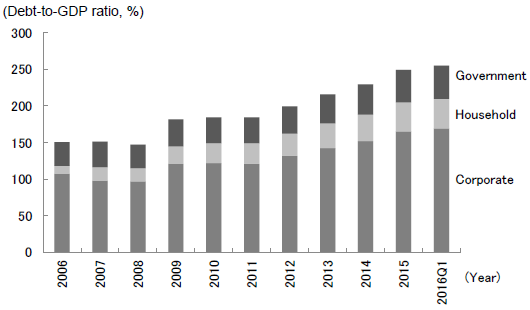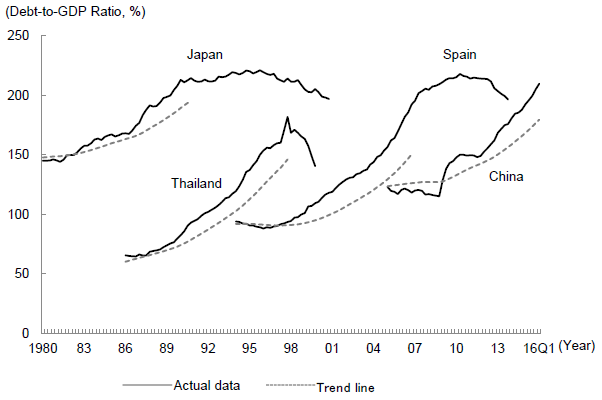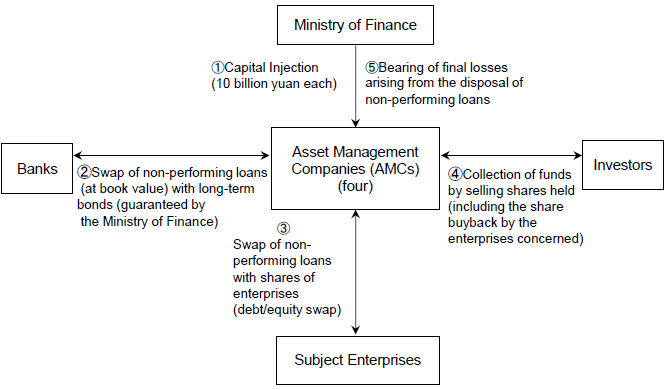Since the 2008 global financial crisis, corporate debt has been increasing sharply in China, and international institutions such as the International Monetary Fund (IMF) and the Bank for International Settlement (BIS) have voiced concerns that an increase in non-performing bank loans associated with the slower economy could trigger an economic crisis. Recognizing the seriousness of the problem, the Chinese government is taking measures centered on swapping corporate debt (bank loans) for equity (i.e., debt/equity swaps).
Corporate debt surging
In China, the ratio of the total debt of the government and the private non-financial sector (composing the corporate and household sectors) to gross domestic product (GDP) rose from 147.0% in 2008 to 254.9% in the first quarter of 2016. In the private non-financial sector alone, the ratio of debt to GDP rose from 115.3% to 209.8%, with the ratio of corporate debt to GDP climbing from 97.2% to 169.1% (Figure 1).

The sharp rise in debt was triggered by the implementation of large-scale stimulative measures totaling four trillion yuan following the global financial crisis. Many investment projects included in these measures were carried out mainly by state-owned enterprises (SOEs) and funded by loans from state-owned banks. The "soft budget constraint"--whereby even if a project fails and debt goes into default, losses are covered by the government and the people involved are rarely held accountable--has caused moral hazard on both the lending side and the borrowing side and boosted debt accumulation.
Reflecting a fall in the economic growth rate from 2011, industries such as steel and coal that received a benefit from the stimulative measures have accumulated excess debt along with excess production capacity, and their ability to repay this debt has become questionable. In fact, the ratio of non-performing loans of commercial banks has been rising since 2013, while the provision coverage ratio has been declining. There is also concern that the capital adequacy ratio may fall (Table 1).
| Year | Balance of non-performing loans (billion yuan) | Non-performing loan ratio (%) | Provision coverage ratio (%) | Capital adequacy ratio (%) |
|---|---|---|---|---|
| 2006 | 1,254.9 | 7.09 | - | - |
| 2007 | 1,268.4 | 6.17 | 41.4 | 8.4 |
| 2008 | 560.3 | 2.40 | 116.6 | 12.0 |
| 2009 | 497.3 | 1.58 | 153.2 | 11.4 |
| 2010 | 433.6 | 1.13 | 217.7 | 12.2 |
| 2011 | 427.9 | 0.96 | 278.1 | 12.7 |
| 2012 | 492.9 | 0.95 | 295.5 | 13.3 |
| 2013 | 592.1 | 1.00 | 282.7 | 12.2 |
| 2014 | 842.6 | 1.25 | 232.1 | 13.2 |
| 2015 | 1,274.4 | 1.67 | 181.2 | 13.5 |
| 2016Q3 | 1,493.9 | 1.76 | 175.5 | 13.3 |
| Note: Values at period end | ||||
| Source: Compiled by the author based on the CEIC database (original data from the China Banking Regulatory Commission) | ||||
The experiences of many countries that were forced to reduce debt, including Japan, Thailand, and Spain, suggest that a situation whereby the debt-to-GDP ratio of the private non-financial sector sharply exceeds its trend line is not sustainable (Figure 2). Based on this criterion, the IMF warns that China is vulnerable to a financial crisis (IMF, "People's Republic of China," Staff Report for the 2016 Article IV Consultation, July 7, 2016).
— Comparison with Japan, Thailand, and Spain —

The return of debt/equity swaps
With the aim of reducing corporate debt, the Chinese government (State Council) issued Opinions on Positively and Steadily Reducing the Leverage Ratio of Enterprises ("Opinions on Reducing the Leverage Ratio") and Guiding Opinions on Market-oriented Debt-for-Equity Swaps between Banks ("Opinions on Debt-for-Equity Swaps") as its appendix on October 10, 2016. In the former, as a means of reducing the leverage ratio of enterprises, the following seven approaches are listed: (1) mergers and restructuring of enterprises, (2) strengthening of corporate governance, (3) tapping underutilized assets of enterprises, (4) optimization of the financial structure of enterprises, (5) promotion of debt/equity swaps of banks based on the market rules, (6) implementation of business bankruptcy based on the law, and (7) promotion of equity financing. In the latter, the policy for implementing the debt/equity swaps of banks in (5) is presented in detail.
This is not the first time that China has promoted debt/equity swaps. In 1999, when China was still coping with the aftermath of the Asian currency crisis, the non-performing loans of the four major banks (Industrial and Commercial Bank of China, Agricultural Bank of China, Bank of China, China Construction Bank) were transferred to four newly established asset management companies (AMCs) by exchanging them for long-term bonds guaranteed by the Ministry of Finance at book value, and some of the non-performing loans were converted into shares issued by the enterprises concerned (Figure 3). As a result, the claims of the AMCs against enterprises take the form of shares instead of loans, while the enterprises assumed an obligation to pay dividends to the AMCs that have become shareholders, instead of repaying the principal and interest to banks. If the business performance of the enterprises improves, the dividends will increase and the share price will rise, and the profits of the AMCs will increase when they dispose of the shares. For the four major banks, non-performing loans that they have held will change to performing loans, and the government will bear the final losses arising from the disposal of the non-performing loans by the AMCs.
— Centered on Debt/Equity Swaps —

Debt/equity swaps at the end of the 1990s were conducted under the auspices of the government in all processes from the selection of enterprises be covered to financing, price setting, and the disposal of shares. In contrast, Opinions on Debt-for-Equity Swaps emphasizes the market orientation (standing on the market rules) and the rule of law (complying with the law) in the debt/equity swaps this time (Table 2). Specifically, the enterprises to be covered, transaction prices, and implementation agencies are not decided by the government, but through voluntary discussions among the market entities, and the necessary funds are raised from the market. The government does not assume responsibility for covering losses.
| Item | Previous instance (1999) | Current instance (2016) |
|---|---|---|
| Purpose | Disposal of non-performing loans of banks | Reduction of corporate debt |
| Overall policy | Under the auspices of the government | Market orientation and the rule of law |
| Enterprises to be covered | Including zombie enterprises designated by the government | Determined in discussions among the related parties in line with the government policy. Zombie enterprises are not included. |
| Implementation agencies | Asset management corporations (AMCs) - Capital injection by the Ministry of Finance - Four AMCs were established, one corresponding to each of the major banks |
Use private capital such as insurance assets management companies and state-owned capital operating companies, in addition to existing AMCs. |
| Transaction price of non-performing loans | Transfer from banks to AMCs at book value | Based on the market principle |
| Transaction price of debt/equity swaps | Under the auspices of the government | Based on the market principle |
| Source of funds | Issuance of long-term bonds guaranteed by the Ministry of Finance and loans from the central bank | Raising funds from the market and the use of private capital |
| Exit strategy (collection of funds through the disposition of shares) | Centered on buybacks by the enterprises concerned | Use of the multi-layered capital market |
| Bearing of final losses arising from the disposal of non-performing loans | Government | Market entities involved in transactions |
| Source: Compiled by the author based on various materials. | ||
This time, the market economy institution and related laws are more developed than last time, and the ownership structure has also become more diversified. In addition, the governance structure of the market entities including enterprises, banks, and the implementation agencies have become sounder, and the capital market is also maturing. With these environmental changes as a backdrop, the implementation of debt/equity swaps according to the policies of market orientation and the rule of law has become possible.
The scope of enterprises to be covered
Opinions on Debt-for-Equity Swaps shows a positive list and a negative list with respect to what kind of enterprise will be covered.
The following three types of enterprises for which a debt/equity swap is encouraged are included on the positive list:
(1) Enterprises that have temporarily run into financial difficulty because of the economic cycle but are expected to recover
(2) Growing enterprises with too much debt, particularly those in strategic emerging industries
(3) Leading enterprises in an industry with a large amount of debt and excess production capacity and strategic enterprises that are related to national security
Meanwhile, on the negative list, the following four types of enterprises for which a debt/equity swap is prohibited are listed:
(1) Zombie enterprises with no prospect for survival
(2) Enterprises that do not fulfill repayment obligations intentionally and have lost credibility
(3) Enterprises with a possible deepening of excess production and increasing inventories
(4) Enterprises with complex and unclear debt relationships
The positive list and the negative list are simply mechanisms for determining the scope of enterprises subject to debt/equity swaps, and the government is not involved in the selection of individual enterprises.
Implementation agencies to act according to the market rules
According to Opinions on Debt-for-Equity Swaps, banks are not allowed to conduct debt/equity swaps directly. This role should be played by implementation agencies that buy loans from banks.
Financial asset management corporations, insurance asset management companies, and state-owned capital operating companies are encouraged to participate as implementation agencies in debt/equity swaps based on the market rules. In addition to using their existing affiliated institutions with the required qualifications, banks are also permitted to establish new institutions to carry out debt/equity swaps. The implementation agencies are encouraged to strengthen their capital base by introducing private capital.
Fund-raising from the market and exit strategies through the multi-layered capital market
According to Opinions on Debt-for-Equity Swaps, the implementation agencies will raise funds on their own based on the market rules this time, in contrast to the previous debt/equity swaps under the auspices of the government. The government will not bear final losses, although it will support fundraising through the provision of preferential tax treatment in fundraising and the issuance of financial bonds by the implementation agencies.
The implementation agencies are also able to decide on the disposition methods (exit strategies) of shares they have acquired through debt/equity swaps in consultation with the enterprises concerned. In the case of a listed company, its shares can be sold via the stock market. In the case of an unlisted company, its shares can be sold through channels such as mergers and acquisitions (M&As), registration in the national share transfer system for small and medium enterprises, transactions on a local equity market, and listing on a stock exchange.
Role of the government
Opinions on Debt-for-Equity Swaps states that the role of the government is to set debt/equity swaps on the track of market orientation and the rule of law and promote them in a calm manner through the provision of social safety nets such as the establishment of rules, development of policies, supervision based on the law, maintenance of an orderly market that promotes fair competition, maintenance of social stability, and protection of the legal interests of employees.
Specifically, acts such as the following of the government and its agencies are prohibited:
(1) Interfering in the specific operations of a market entity in debt/equity swaps
(2) Designating enterprises that will conduct debt/equity swaps
(3) Forcing banks to conduct debt/equity swaps
(4) Designating specific bank loans for debt/equity swaps
(5) Interfering in the setting of prices and conditions of debt/equity swaps
(6) Interrupting the exercise of rights of shareholders
(7) Interfering in the daily management of enterprises that have conducted debt/equity swaps
Purpose of debt/equity swaps in the current instance
According to Opinions on Debt-for-Equity Swaps, the purpose of the current round of debt/equity swaps is to stabilize growth, promote reforms, make an adjustment to the economic structure, and prevent risks through the following:
(1) Reduction of leverage, enhancement of capital, and prevention of debt risk of enterprises
(2) Reduction of costs, improvement of efficiency and competitiveness of enterprises, and realization of survival of the fittest
(3) Diversification of shareholders and restructuring of enterprises, and development of the modern corporate system
(4) Construction of a multi-layered capital market, improvement of the direct financing ratio, and optimization of financing routes
At the same time, based on the recognition that the banking industry in China is sound, the authorities emphasize that the major objective of debt/equity swaps is not to reduce risks in the banking system (Briefing on the Opinions on Positively and Steadily Reducing the Leverage Ratio of Enterprises a press conference held by the State Council Information Office on October 12, 2016). However, if the business performance of SOEs with excess production capacity deteriorates further and the housing bubble bursts, non-performing loans of banks would increase sharply. Thus, debt/equity swaps should also be interpreted as an attempt by the government to maintain the stability of the banking system by curbing the rise in non-performing loans.
Conditions for success
David Lipton, first deputy managing director of the International Monetary Fund (IMF), suggests that the following three measures are necessary to achieve the reduction of corporate debt and non-performing loans of banks in light of the experiences of other countries (Lipton, David, "Rebalancing China: International Lessons in Corporate Debt" Speech delivered at the China Economic Society Conference on Sustainable Development in China and the World, Shenzhen, China, June 11, 2016).
First, act quickly and effectively, or the problem will only worsen. Company debt problems today can become systemic debt problems tomorrow. Systemic debt problems can lead to much lower economic growth and/or a banking crisis.
Second, when you act, make sure to deal with both creditors and debtors. Some countries have just moved bad loans off bank balance sheets and recapitalized the banks. Companies were left unprofitable. Others have downsized companies or allowed them to go under. Banks were left undercapitalized. It is best to fix both.
Third, when fixing corporate and bank balance sheets, address the governance problems in the corporate and banking sectors that gave rise to the problem in the first place. Otherwise, deflating the debt bubble will bring only temporary effect. A new debt bubble will surely re-inflate if unwarranted lending and borrowing can just resume.
Although the debt/equity swaps to be conducted in China this time are in accordance with the first two policies, the strengthening of the governance of enterprises (particularly SOEs) and banks needs to be accelerated based on the third policy in order to fully solve the problems.
The original text in Japanese was posted on December 16, 2016.


